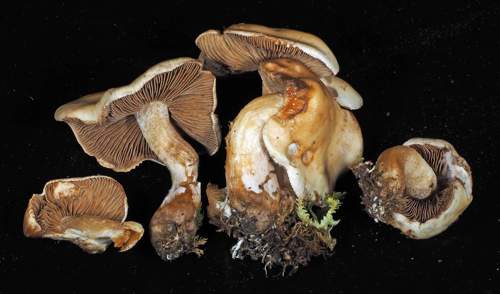 Hebeloma asperosporum (Photo: K. Hosaka)
Hebeloma asperosporum (Photo: K. Hosaka)Taxonomy
Full name: Hebeloma asperosporum Beker & U. Eberh., Mycol. Prog. 21: 459 (2022)Genus: Hebeloma
Section: Denudata
Subsection: Clepsydroida
Types: JAPAN: Kagoshima, Amami-Oshima Island, Amami Forest Polis Park, Naon,Yamato son,Oshima gun (approx. 28.3161°N, 129.3448°E, alt. approx. 215 m a.s.l.) under Castanopsis sieboldii, Pinus luchuensis and Quercus glauca, 17 Nov. 2015, K. Hosaka (JPN15-1538) (Holotype. herbarium acc. no. TNS-F-75705, HJB16251).
- arrow_drop_downarrow_drop_upEtymologyFrom asper (adj. Latin) meaning rough and spora (Latin) to emphasize the rough spores.
- arrow_drop_downarrow_drop_upDiagnosisThe small, strongly ornamented spores, on average less than 10.5 μm long, indextrinoid and with consistently loosening perispore distinguishes this species from other known members of H. section Denudata.
References
Description
- arrow_drop_downarrow_drop_upThresholds
Description of Hebeloma asperosporum based on 2 collections
- arrow_drop_downarrow_drop_upMacroscopic descriptionPileus: (21) 29–52 (58) mm diameter; shape convex, often umbonate; characters spotting; margin characters often crenulate or eroded; viscosity tacky when moist; colour variation often unicolour or two color; colour at centre occasionally clay-buff, honey or dark pinkish buff.
Lamellae: attachment emarginate; maximum depth not recorded; number of complete lamellae 70–72; presence of tears often visible with x10 lens or visible with naked eye; white fimbriate edge often present or very strong.
Cortina presence: no.
Stipe: (26) 32–56 (77) x (5) 6–8 (11) {median} x (6) 7–10 (13) {basal} mm; stipe Q 4.7–7.0; base shape clavate; floccosity fibrillose or pruinose at apex; rooting no; thick rhizoids at base absent;
Context: Texture firm; stipe interior Not recorded; stipe flesh discolouring yes; slenderness measure 5.8–6.8; smell Not recorded; taste Not recorded.
Spore deposit colour: Not recorded.
Exsiccata characters: Not recorded.
- arrow_drop_downarrow_drop_upMicroscopic descriptionSpores: shape amygdaloid or limoniform; colour in microscope brown; guttules yes. papilla often yes or very strongly; Spore Code: O3 O4; P3; D0.
Basidia: 22–30 x 6–8 μm; ave. Q 3.2–3.6; spore arrangement 4 spored;
Cheilocystidia: main shape clavate-lageniform or clavate-ventricose, often capitate-stipitate or clavate-stipitate; special features observed often clamped septa or median thickening; cheilocystidia ratios: A/M = 1.79–1.91; A/B = 1.30–1.49; B/M = 1.36–1.41.
Pleurocystidia: none seen.
Ixocutis: epicutis thickness (measured from exsiccata) up to 150 μm; ixocutis hyphae width up to 6 μm; ixocutis hyphae encrustation yes; shape of trama elements beneath subcutis cylindrical or thickly sausage-shaped up to 16 μm wide.
Caulocystidia: Similar to cheilocystidia but larger, up to 110 μm.
- arrow_drop_downarrow_drop_upSpore measurements
- arrow_drop_downarrow_drop_upCheilocystidia measurements
- arrow_drop_downarrow_drop_upHabitat and distributionNo collections have been recorded where there was only one possible associate. We have additional records where Pinus, Quercus and Castanopsis were recorded as possible associates, but in these cases a number of possible associates were always mentioned. Overall the most commonly recorded families are Pinaceae (100.0%) and Fagaceae (100.0%) The growth habit of our collections was scattered and often caespitose.
According to our current collections, the species is found only in Asia-Temperate. On the continent, collections have been found only in the Nansei Islands subtropical evergreen forests WWF ecoregion The World Wildlife Fund (WWF) have divided the world into 867 terrestrial ecoregions. The ecoregion here is estimated by mapping from the GPS coordinates of the collection using data made available by Dinerstein et al (2017). Use this webtool to explore the ecoregions visually or see a full list of current ecoregions on Wikipedia. (tropical & subtropical moist broadleaf forests biome). From collector information, it appears collections have been found in the IUCN habitats We map from the collector's description of the habitat to the International Union for Conservation of Nature (IUCN)'s definition using a standardised set of rules. Please see this page for a full list of IUCN habitats.. Within Temperate Asia all our records are from Eastern Asia (Japan).
- arrow_drop_downarrow_drop_upCommentaryThe mainly clavate-ventricose cheilocystidia together with distinctly to strongly ornamented spores support the placement of this taxon in H. subsect. Clepsydroida within H. sect. Denudata. The occasional presence of cystidia with thickening of the wall in the middle is further evidence of this placement. Molecularly, the position of the species within H. sect. Denudata is supported, but its assignment to subsection is not. Within H. sect. Denudata, the small spores, on average less than 10.5 μm long, indextrinoid but strongly ornamented and with consistently loosening perispore distinguishes this species from all other known members of H. section Denudata. While the description is based on just two collections, its morphological and molecular separation, from all known species of Hebeloma, leave us in no doubt that this should be regarded as a distinct species. Of course, our description and knowledge of this taxon is limited to just these two collections from the same locality, hence our concept of this species is limited. A sequence published from China as H. alpinum (MW554385, Zouh, unpublished, submitted 26 Jan 2021; no UNITE SH to date) is, apart from obvious editing errors, identical to our H. asperosporum sequences. It is hoped that publishing this descriptionwill encourage other mycologists to search for this taxon. Japanese name: Amami-wakafusa-take (Eberhardt et al. 2022b).
Geographic distribution
Phenology
- arrow_drop_downarrow_drop_upAdditional cited collections